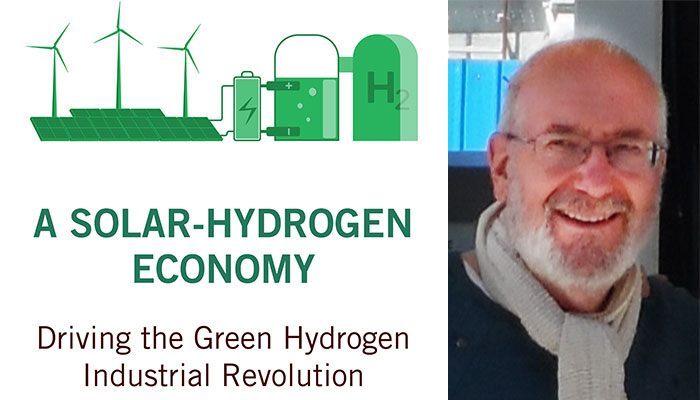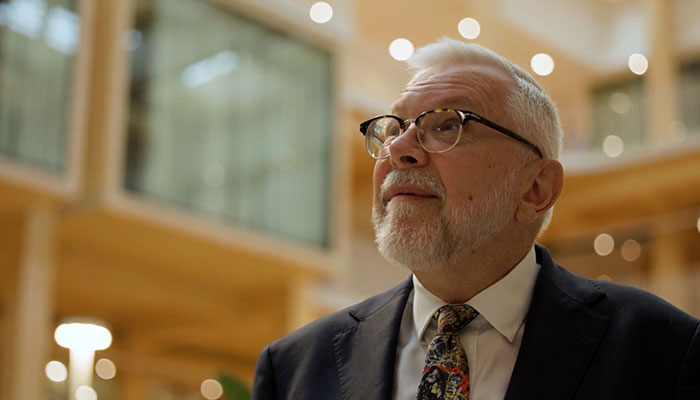Professor John Mathews has done the maths and his newest book, A Solar-Hydrogen Economy: Driving the Green Hydrogen Industrial Revolution, shows green hydrogen has the capability to completely replace the global, 12-billion tonne, fossil fuel-driven energy system.

Mathews’ research found each year, the fossil fuel industry uses 12 billion tonnes of oil equivalent to produce, in energy terms, around 500 exajoules per annum.
“An exajoule is a huge quantity of energy - the energy of a volcanic explosion, for example - and the energy content of the fossil fuel system is as much as 500 of those, every year,” says Mathews.
Mathews says his book aims to offer a clear guide on how to practically replace fossil fuels with green hydrogen, with a focus on the fiscal benefits.
Green hydrogen is produced using electricity from renewable energy sources such as wind or solar power. One green hydrogen method involves running an electric current generated by wind turbines or solar panels through water using an instrument called an electrolyser to split the hydrogen from the water.
Complicating Mathews' calculations, different energy sources (like coal, oil or hydrogen) vary in the amount of energy they create by volume, because each has distinct combustion properties and energy densities.
For example, a tonne of coal will generate a different amount of energy than the same volume of oil, which will be different again to a tonne of hydrogen.
To replace the equivalent quantity of energy produced by today's entire fossil fuel industry, we would need to produce close to 4 giga tonnes (4 billion tonnes) of green hydrogen per year, estimates Mathews – resulting in an industry of $12 trillion by 2050.
The ‘green industrial revolution’ is not a moral decision
Mathews says his book aims to offer a clear guide on how to practically replace fossil fuels with green hydrogen, with a focus on the fiscal (rather than moral) benefits.
“I’m not starting with the moral imperative; ‘we must do this to solve the climate problem’; what I'm doing is saying here is a real, industrial, renaissance possibility that is feasible and technologically quite viable, but it needs investment on a huge scale to drive it and along the way, it will actually solve the climate problems we all want to see addressed,” says Mathews.
“The industrial miracle of substituting fossil fuels with another energy source is already starting to happen,” he says.
Green hydrogen will generate jobs
As the global energy crisis pushed coal prices to historic highs, in 2021-22, coal became Australia’s second most valuable export, after iron ore.

The future of power: In his new book Professor Mathews (pictured) says green hydrogen has the potential to generate more jobs than the fossil fuel economy.
This has prompted potential job losses from tackling climate change, to become a major concern for Australians, exacerbated by recent closures such as the Hazelwood Power Station and Mine in Victoria’s Latrobe Valley.
However Mathews says green hydrogen has the potential to generate more jobs than those currently provided through the fossil fuel economy.
“In the Latrobe Valley there are a lot of people tied to the big coal burning power generators. But there are also a lot of ideas now for producing green hydrogen in the Latrobe Valley and driving a green industrial revolution from that,” he says.
Mathews says other big fossil fuel industrial areas like Gladstone in Queensland and the Hunter Valley and Wollongong in New South Wales, are seeing innovation in the green hydrogen space, and a promise of a greener industrial future for Australia.
The University of Wollongong, and company Hysata, in particular is using a “world-leading innovation” through their Capillary Fed Electrolysis (CFE) which Mathews can see holds potential for an enormous industry.
Australia in prime position to be a leader
An abundance of natural resources and ability to scale, as well as advancements in hydrogen technology being created locally, all help position Australia on the cusp of being a major global producer of green hydrogen.
Mathews cites intercontinental renewable power grid projects (such as the now-teetering Sun Cable project in the Northern Territory) as signs that there is vast potential to use green hydrogen to export power internationally.
“There is a real possibility for Australia to have a real green Industrial Revolution, and replace exports of coal and natural gas with exports of green hydrogen to big markets like China, Korea and Japan,” says Mathews.
Mathews notes that in certain industries, solar, wind and battery storage are less feasible, but these could instead use hydrogen fuel cell engines fed by green hydrogen, for example, in transport, where these engines could easily power vehicles from cars up to commercial trucks, trains, and shipping supply chains.
Other sectors that can use hydrogen include steel, cement, aluminium and agriculture – where work is already underway developing ammonia as a basis for green fertilisers.
“There are all different industrial pathways through which green hydrogen could make its contribution, and every one of them is reducing carbon emissions, greening the economy, creating green jobs and promoting investments in new green industries,” he says.
“The whole thing amounts to a green industrial revolution. That’s what I hope will be the take home message of the book: that a Green Industrial Revolution is feasible and imminent.”
John Mathews is Emeritus Professor at the Macquarie Business School and is the author of books including the Greening of Capitalism and Global Green Shift. His latest book is available through Anthem Press.



